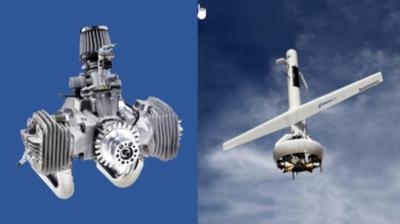Thu, Apr 06, 2017
Demonstrated Hover And Transition To Horizontal Flight
Goebler-Hirthmotoren GmbH & Co. KG (Hirth Motors) has been working with MartinUAV on a new propulsion system for their V-BAT transitional vertical take-off and landing (VTOL) to improve operational endurance and to add heavy fuel capability. MartinUAV successfully flew this new gasoline engine on February 28th and demonstrated hover and transitioned to horizontal flight. The engine that MartinUAV integrated and flew in the V-Bat was Hirth's 15hp 4201 air-cooled 2-stroke boxer engine.

"VTOL's are very popular because of their runway independence and MartinUAV's transitional solution offers the endurance benefits of a fixed wing and take-off/landing benefits of a helicopter," said Hirth's CEO, Heinz Waras. "This eliminates the need for launchers, runways or capture methods. Also, the ducted fan solution keeps operators safe compared to rotary wing solutions. The combination of MartinUAV's air vehicle benefits and Hirth's propulsion benefits provide an opportunity for both companies to expand their UAV business."
Features of the 183cc 4201 engine include advanced closed loop fuel control to optimize performance, CAN bus or RS485 interface for easy communication with the V-Bat flight computer, on-board data storage of engine run parameters allowing post flight analysis, shielded ECU/harness to protect against electromagnetic interferance (EMI), 1kW starter/generator to provide remote start and air vehicle electrical power.
It also features automatic altitude and temperature compensation enabling reliable start and operation in a wide operating range. Temperature: -40 to +50 degree C (-40 to +122 degree F). Altitude: 0 - 6000m (0 - 20,000 ft.). The 4201 variant integrated to the V-Bat can also be adapted with a 1:2 reduction drive for fixed wing applications to spin a larger propeller to reduce noise and increase thrust. There is also an optional iPower variant of the 4201 engine that enables spark ignition operation on heavy fuel. This will allow MartinUAV to meet NATO's one fuel policy which eliminates gasoline for safety and logistic reasons.
Hirth has been producing engines since 1917 and their reputation for reliable lightweight 2-stroke engines in the sport aviation market has helped expand their UAV business over the years as the global demand for UAV engines increases. Hirth is currently flying on several high end global UAV platforms and has been advancing their engine technology to improve performance and reliability for the UAV market.
(Image provided with Hirth media release)
More News
Aero Linx: Model Aeronautical Association of Australia MAAA clubs are about fun flying, camaraderie and community. For over 75 years, the MAAA has been Australia’s largest fl>[...]
Touchdown Zone Lighting Two rows of transverse light bars located symmetrically about the runway centerline normally at 100 foot intervals. The basic system extends 3,000 feet alon>[...]
“Discovery and innovation are central to our mission at Virgin Galactic. We’re excited to build on our successful record of facilitating scientific experiments in subor>[...]
How To Get A Story On Aero-TV News/Feature Programming How do I submit a story idea or lead to Aero-TV? If you would like to submit a story idea or lead, please contact Jim Campbel>[...]
Student Pilot Reported That During Rotation, “All Of A Sudden The Back Of The Plane Kicked To The Right..." Analysis: The student pilot reported that during rotation, “>[...]
 ANN's Daily Aero-Linx (05.02.24)
ANN's Daily Aero-Linx (05.02.24) ANN's Daily Aero-Term (05.02.24): Touchdown Zone Lighting
ANN's Daily Aero-Term (05.02.24): Touchdown Zone Lighting Aero-News: Quote of the Day (05.02.24)
Aero-News: Quote of the Day (05.02.24) ANN FAQ: Contributing To Aero-TV
ANN FAQ: Contributing To Aero-TV NTSB Final Report: Cirrus Design Corp SR20
NTSB Final Report: Cirrus Design Corp SR20



